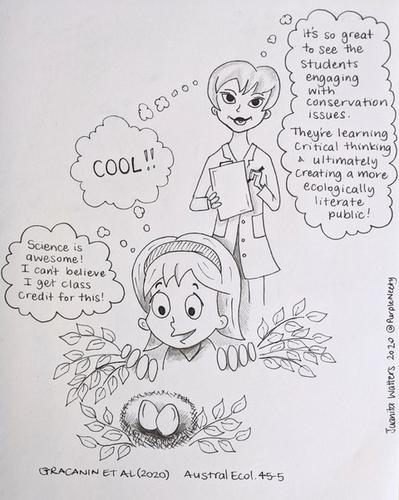当前位置:
X-MOL 学术
›
Austral Ecol.
›
论文详情
Our official English website, www.x-mol.net, welcomes your feedback! (Note: you will need to create a separate account there.)
An artificial bird nest experiment in urban environments: Lessons from a school‐based citizen science programme
Austral Ecology ( IF 1.5 ) Pub Date : 2020-03-10 , DOI: 10.1111/aec.12859 Ana Gracanin 1 , Erin Roger 2 , Andrew C. Katsis 3 , Luke S. O’Loughlin 4, 5 , Nathan J. Emery 6 , Joanne F. Ocock 7 , James C. O’Hanlon 8
Austral Ecology ( IF 1.5 ) Pub Date : 2020-03-10 , DOI: 10.1111/aec.12859 Ana Gracanin 1 , Erin Roger 2 , Andrew C. Katsis 3 , Luke S. O’Loughlin 4, 5 , Nathan J. Emery 6 , Joanne F. Ocock 7 , James C. O’Hanlon 8
Affiliation

|
Maintaining suitable vegetation within urban environments is crucial for wildlife conservation in the face of anthropogenic habitat change. Here, we report on a citizen science project, involving students from seven schools across south‐eastern Australia, that investigated the effectiveness of urban vegetation as habitat for bird nests. The ‘nest concealment hypothesis’ posits that vegetation should obscure the nest from predator detection, thus reducing the likelihood of predation. To test this, participating school‐aged citizen scientists constructed artificial nests, which were placed in garden trees within school grounds and monitored for signs of predation. We found no evidence to support the nest concealment hypothesis, with no relationship between the density of vegetation immediately surrounding a nest and its likelihood of predation (binomial model:  = 1.714, P = 0.190). It was observed that 80% of the nests experienced predation. This aligns with mounting evidence suggesting that other factors, such as olfaction and adult defence, may be more important factors in the protection of bird nests. It is important to note that artificial nests are unreliable, and therefore, the veracity of the overall conclusions is limited. However, in conducting this experiment, we demonstrate the suitability of this method as a school‐based citizen science activity. This study exemplifies that field‐based experiments can used to engage future generations with conservation science.
= 1.714, P = 0.190). It was observed that 80% of the nests experienced predation. This aligns with mounting evidence suggesting that other factors, such as olfaction and adult defence, may be more important factors in the protection of bird nests. It is important to note that artificial nests are unreliable, and therefore, the veracity of the overall conclusions is limited. However, in conducting this experiment, we demonstrate the suitability of this method as a school‐based citizen science activity. This study exemplifies that field‐based experiments can used to engage future generations with conservation science.
中文翻译:

城市环境中的人工燕窝实验:基于学校的公民科学计划的经验教训
面对人为的栖息地变化,在城市环境中保持适当的植被对于野生生物保护至关重要。在这里,我们报告了一项公民科学项目,该项目涉及澳大利亚东南部七所学校的学生,该项目调查了城市植被作为燕窝栖息地的有效性。“巢藏匿假说”认为,植被应从捕食者的视线中遮盖住巢穴,从而减少捕食的可能性。为了测试这一点,参加研究的学龄公民科学家建造了人工巢,将它们放置在校园内的花园树木中,并监测其掠食迹象。我们发现没有证据支持巢藏匿假说, = 1.714,P = 0.190)。据观察,有80%的鸟巢经历了捕食。这与越来越多的证据相吻合,表明其他因素,例如嗅觉和成年防御,可能是保护燕窝的更重要因素。重要的是要注意人工窝是不可靠的,因此,总体结论的准确性受到限制。但是,在进行此实验时,我们证明了此方法适合作为基于学校的公民科学活动。这项研究例证了基于野外的实验可以使后代参与保护科学。
= 1.714,P = 0.190)。据观察,有80%的鸟巢经历了捕食。这与越来越多的证据相吻合,表明其他因素,例如嗅觉和成年防御,可能是保护燕窝的更重要因素。重要的是要注意人工窝是不可靠的,因此,总体结论的准确性受到限制。但是,在进行此实验时,我们证明了此方法适合作为基于学校的公民科学活动。这项研究例证了基于野外的实验可以使后代参与保护科学。
更新日期:2020-03-10
 = 1.714, P = 0.190). It was observed that 80% of the nests experienced predation. This aligns with mounting evidence suggesting that other factors, such as olfaction and adult defence, may be more important factors in the protection of bird nests. It is important to note that artificial nests are unreliable, and therefore, the veracity of the overall conclusions is limited. However, in conducting this experiment, we demonstrate the suitability of this method as a school‐based citizen science activity. This study exemplifies that field‐based experiments can used to engage future generations with conservation science.
= 1.714, P = 0.190). It was observed that 80% of the nests experienced predation. This aligns with mounting evidence suggesting that other factors, such as olfaction and adult defence, may be more important factors in the protection of bird nests. It is important to note that artificial nests are unreliable, and therefore, the veracity of the overall conclusions is limited. However, in conducting this experiment, we demonstrate the suitability of this method as a school‐based citizen science activity. This study exemplifies that field‐based experiments can used to engage future generations with conservation science.
中文翻译:

城市环境中的人工燕窝实验:基于学校的公民科学计划的经验教训
面对人为的栖息地变化,在城市环境中保持适当的植被对于野生生物保护至关重要。在这里,我们报告了一项公民科学项目,该项目涉及澳大利亚东南部七所学校的学生,该项目调查了城市植被作为燕窝栖息地的有效性。“巢藏匿假说”认为,植被应从捕食者的视线中遮盖住巢穴,从而减少捕食的可能性。为了测试这一点,参加研究的学龄公民科学家建造了人工巢,将它们放置在校园内的花园树木中,并监测其掠食迹象。我们发现没有证据支持巢藏匿假说,
 = 1.714,P = 0.190)。据观察,有80%的鸟巢经历了捕食。这与越来越多的证据相吻合,表明其他因素,例如嗅觉和成年防御,可能是保护燕窝的更重要因素。重要的是要注意人工窝是不可靠的,因此,总体结论的准确性受到限制。但是,在进行此实验时,我们证明了此方法适合作为基于学校的公民科学活动。这项研究例证了基于野外的实验可以使后代参与保护科学。
= 1.714,P = 0.190)。据观察,有80%的鸟巢经历了捕食。这与越来越多的证据相吻合,表明其他因素,例如嗅觉和成年防御,可能是保护燕窝的更重要因素。重要的是要注意人工窝是不可靠的,因此,总体结论的准确性受到限制。但是,在进行此实验时,我们证明了此方法适合作为基于学校的公民科学活动。这项研究例证了基于野外的实验可以使后代参与保护科学。



























 京公网安备 11010802027423号
京公网安备 11010802027423号